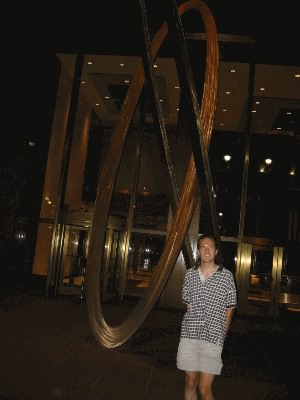This course is defined, in many
ways, by what it isn't. It isn't the easy way out of
calculus II - in fact, it will likely be more demanding than 222
would be. It isn't merely the same topics from 222 with
examples using biology. It is a completely different
experience than 222. Some 222 topics will not be included,
most notably infinite series. We will learn many topics not
studied in 222 - including probability and statistics, and many
topics not studied in other mathematics courses - such as discrete
dynamical systems. You will be my experts on biology, and I
will be the mathematics expert. Along the way we will surely
all learn something we never knew before. Be prepared to
work, to learn, and to see some new and different things.
Open your minds and hold on for a biology flavoured adventure in
mathematics.
AMS national meeting in New Orleans, January 10 - 13, 2001.
"Colored Unlinking", special session
on geometry and topology of low dimensional manifolds.
"Temperament of Mind: Hector Berlioz and Evariste Galois",
contributed paper.
AMS sectional meeting in Las Vegas, April 21 - 22, 2001.Co-organized special session on the
topology of links.
MAA national MathFest in Madison, August 2 - 4, 2001."Infiltrating Preservice Elementary
School Mathematics with History", contributed paper session on the
use of history in the teaching of mathematics.
"Modern Geometry", contributed paper
session on the use of recent history of mathematics in teaching.
"Welcome to Mathematics: A Cornerstone Experience",
contributed paper session on the role of proof in teaching
mathematics.
MAA national MathFest in Boulder, CO, July 30 - August 2, 2003"Days are Numbers: The
Mathematics of the Calendar", general contributed paper session.
"Honesty is the Best Philosophy", contributed paper session on
innovations in quantitative literacy.
MAA national MathFest in Providence, RI, August 11 - 15, 2004
MAA national MathFest in Knoxville,
TN, August 9 - 12, 2006
"A Little Moore Probability",
contributed paper session on current issues in mathematics
education courses.
"Kaleidoscope", general contributed paper session.
MAA national MathFest in San Jose, CA, August 2 - 5, 2007
"Where are we from? - An entire
class project", contributed paper session on getting students
to discuss and to write about mathematics.
"Four dimensional tic-tac-toe on a torus - the game of SET",
general contributed paper session
5th annual Midwest Undergraduate Mathematics Symposium at
Simpson College, Indianola, IA. April 2008
"Game: SET - Math",
invited plenary address
MAA national MathFest in Madison, WI, July 30 - August 2, 2008
"Vedic Decimal Patterns",
contributed paper session on interesting topics in history of
mathematics that enchance the teaching and learning of
mathematics.
"Place Value Airthmetic via Polynomials", contributed paper
session on innovations in mathematics education.
MAA national MathFest in Portland, OR, August 5 - 8, 2009
"Counting Student Groupings",
contributed paper session on fascinating examples from
combinatorics, number theory, and discrete mathematics.
"The Mathematical Fiction and Exposition of Rudy Rucker",
general contributed paper session
MAA national MathFest in Pittsburgh, PA, August 4 - 7, 2010
"Euclid's Neglected
Postulate", contributed paper session on history of
mathematics uses in the classroom.
"Four different experiences", contributed paper session on
first year seminar / experience mathematics courses.
MAA national MathFest in Lexington, KY, August 3 - 6, 2011
"A Mile Wide and an Inch Deep
- 4000 BCE to 1950", general contributed paper session.
"Probability and Strategy in Farkle", contributed paper
session on recreational mathematics.
MAA national MathFest in Madison, WI, August 1 - 4, 2012
"The Flat Earth: The
Mathematics of Mapmaking", general contributed paper
session.
"Editing Episodes - Magazine, Chapter, and More:
Diverse Writing and Editing Projects", contributed paper
session on incorporating writing and editing into
mathematics classes.
MAA national MathFest in Hartford, CT, July 31 - August 3,
2013
"Tinkering with a Mathematical
Goldmine" about
this
website, contributed paper session on recreational
mathematics.
"Spherical Triangle Area and Angle Sum", contributed paper
session on geometry proofs.
MOVES conference at Museum of Mathematics, NYC, August 4 - 6,
2013
"Game: SET - Math" talk
"Kaleidoscopic Mathematics" family activity
MAA national MathFest in Portland, OR, August 6 - 9, 2014
"On the Other Side of the
World, or Right Next Door?", general contributed paper
session.
"Geometry Knows Topology: The Gauß-Bonnet Theorem",
contributed paper session on geometry proofs.
MAA national MathFest in
Washington, DC, August 5 - 8, 2015
"Kaleidoscopic Journey", contributed paper session on
Mathematics and Art.
MAA national MathFest in Columbus, OH, August 4 - 6, 2016
"Take a Ride on the Parallel
Transport", general contributed paper session.
MAA national MathFest in Chicago, IL, July 27 - 29, 2017
"Galois Theory for High School Students", contributed paper
session on Exploring Zeroes of Polynomials.
MAA national MathFest in Denver, CO, August 2 - 4, 2018
"Writing Across the Mathematics
Curriculum", contributed paper session Developing Mathematical
Thinking and Communication Through Writing.
Finger Lakes Master Teacher
Program, Geneseo, NY, February 9, 2019
MAA national MathFest in Cincinnati, OH, July 31 - August 3,
2019
Finger Lakes Master Teacher
Program, Geneseo, NY, January 11, 2020
"Mathematics
and Music" workshop.
MAA Seaway Section Panel, October
8, 2021
"Coordinating
Groupwork Remotely" panelist.
MAA Seaway Section Panel, February
24, 2021
"A Seaway
Conversation on the Course - History of Mathematics" panelist.
MAA national virtual MathFest,
August 4 - 7, 2021
"Needlepoint,
Toplogy, Geometry, and Beyond", contributed paper session
MathArt - ArtMath
MAA national MathFest in
Philadelphia, PA, August 3 - 6, 2022
"Poisson's
exploration of complex line integrals", contributed paper
session Complex Analysis: History, Pedagogy, Innovation, and
Research
MAA national MathFest in Tampa,
FL, August 2 - 5, 2023
"Analsis vs.
Algebra: What is Abstract?", contributed paper session
Analysis and Algebra: Convincing Students They Can Do It
The Future
Among many other things, perhaps a 


